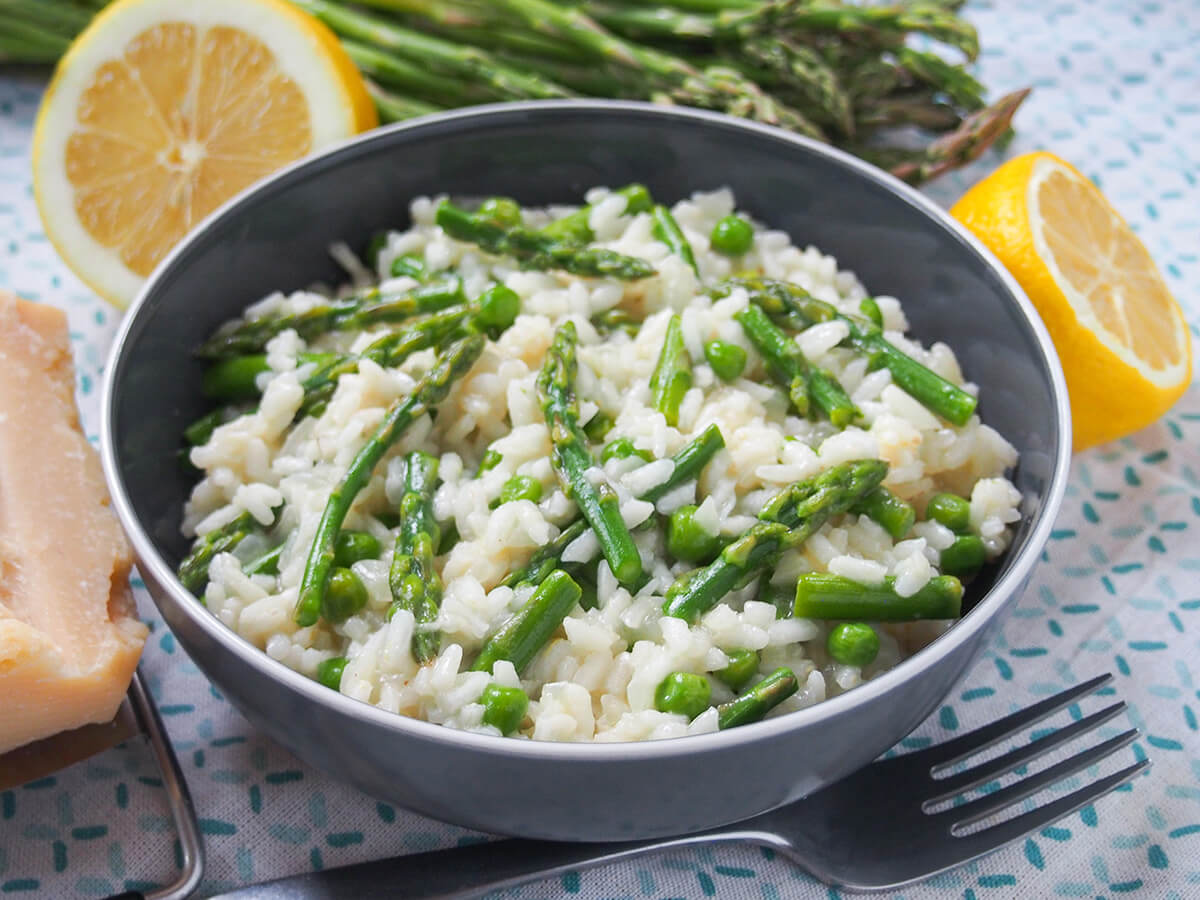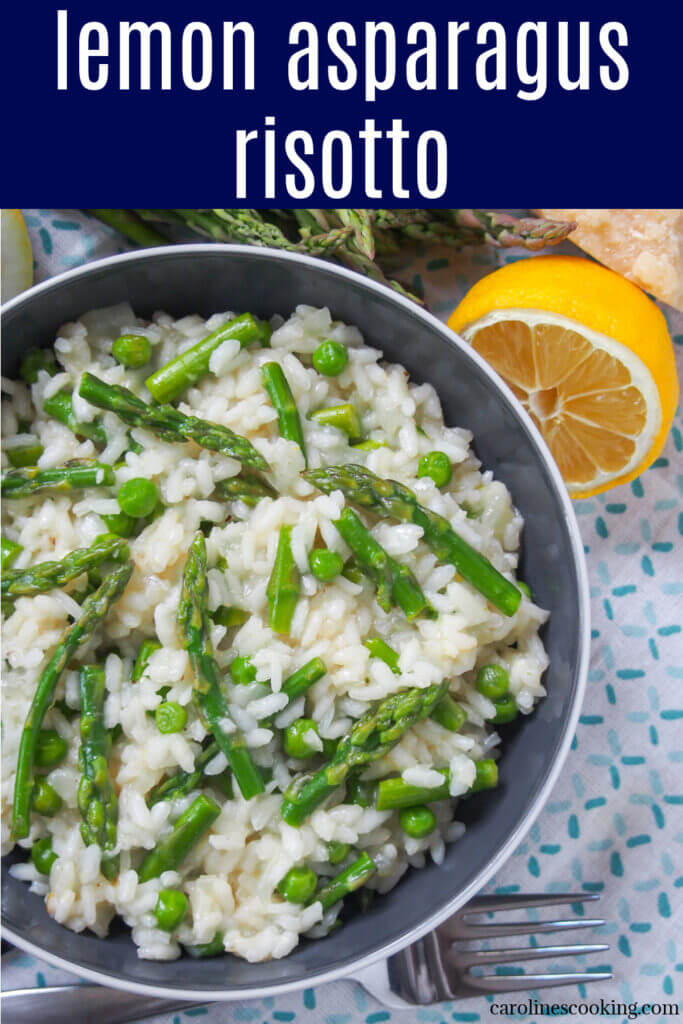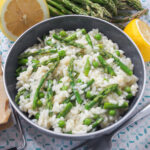Lemon asparagus risotto has all the comfort factor you'd expect in a risotto, with the fresh flavors and colors of spring. It's light and bright, and a delicious main or side.

This post may contain affiliate links, where we earn from qualifying purchases. See more details in the policy page.
Risotto is one of those dishes that some people find a little intimidating. Or simply the idea of needing to stand over it while it cooks is too annoying. I can understand, but in actual fact it's really a lot easier than you might think.
Yes, it takes a little time, and you do need to stir a bit. But you can easily do other things at the same time and just keep coming back to it. And the result is most definitely worth the little effort.

This lemon and asparagus risotto is a lovely bright, spring-inspired take on the classic. It still has the same basic method and texture of a classic risotto, but the lemon added at the end gives it a lighter finish. It's the perfect balance of fresh and comforting.
Risotto origins and core ingredients
Risotto can be traced back to the 16th century and originates in the Northern regions of Italy. Rice was first introduced to Italy in the 14th century by the Arabs, first in Sicily then growing regions gradually moved north. The oldest written recipe is for risotto alla Milanese, saffron risotto, from the 1800s.

Most risottos start with the same base of softened onion and garlic, followed by rice, de-glazing with white wine then stock as the main liquid to cook the rice. Then, you finish the dish off with some parmesan cheese and, often, some extra butter to help build up that creamy texture. Each of these ingredients adds to the flavor and texture of the end dish.
Over the years, the dish has evolved to include variations with a range of additions, from pumpkin risotto to chestnut risotto, versions with mushrooms, seafood and more. This lemon risotto, risotto al limone, is another great variation on the theme.

Tips for making risotto
Since, as I say, risotto can feel a little intimidating, here are some tips to help it work well:
- Use arborio rice, or other rice intended for risotto like carnaroli. This makes a huge difference - these varieties of rice release starch as they cook that gives the creamy texture yet still has a slight bite. Other types of rice don't cook in the same way.
- Use warm stock - it's tempting to not bother heating the stock but this would be a mistake. Warm stock helps the temperature stay constant which helps that starchiness come out. It also helps avoid overcooking as you don't need to turn the temperature up to re-warm it each time you add stock.
- Soften the onion first - this helps to add some sweetness and flavor that you'll taste throughout the dish. So don't rush past it or skip it.
- Toast the rice - this, too, adds to the flavor. It also coats the grains in the fat that helps in how it cooks to get that classic texture.
- Simmer rather than boil - another key to not over-cooking or burning part of the dish is to keep the temperature steady and not too high. You want the rice to absorb the liquid, not just evaporate, so cook over medium heat and reduce if needed.
- Stir, but not too much - you want to stir the rice a bit to help get that texture and for it to cook evenly. But at the same time, you don't want to break up the grains. So, just now and then is fine and best.
- Taste towards the end - you can judge a lot by looking, but it's worth tasting a grain as it seems near done to check. If it has just a little bite, you are close, so are probably at the point of adding the last of the stock (and in the case of this risotto, the vegetables). You don't want to add too much stock that it becomes overcooked and mushy.
- Finish off the heat - add the lemon juice, lemon zest and grated parmesan cheese after you take it off the heat. This saves these ingredients getting too hot which can cause them to not taste quite as good or be the wrong texture.

I know this may sound like a lot, but honestly, it really isn't! With just the tiniest bit of practice, you'll be happy to add it to your regular rotation.
For this particular version, I've made things a little easier by cooking the asparagus and peas in the stock at the end of cooking. There's no need to cook them separately.
Just add the chopped asparagus stems first, with the last ladleful of stock. Then add the asparagus tips and the peas shortly after as they need less time to cook.

Ways to adapt this dish
While I've kept this simple with asparagus and peas, you can easily adapt this to taste. For example:
- Try some other light spring-like vegetables such as arugula or snap peas. While less seasonal, zucchini also works well. Some may need a quite sautee or steam separately to ensure they cook. Whatever you choose, keep them mild in flavor to make sure it doesn't take away from the lemon.
- Dice some salmon and add it at the end to cook in the last of the broth then mix through as you add back the vegetables.
- Add some grilled shrimp or fish such as swordfish or tuna alongside or served on top.
You can serve this dish as a main course in itself, as larger portions, or serve it as a side. It works particularly well with fish and seafood, as mentioned above, as well as with chicken. You could also serve it with various salads.

Try these other savory lemon dishes:
- Lemon pork meatballs
- Avgolemono soup
- Lemon mascarpone pasta
- One pot lemon garlic chicken with vegetables
- Plus get more tasty spring recipes in the archives.
Lemon asparagus risotto
Ingredients
- 8 oz asparagus approximately
- ½ onion
- 2 cloves garlic or 1 if large, depending on size
- 1 tablespoon butter
- 1 tablespoon olive oil
- 1 cup arborio risotto rice
- ¼ cup white wine eg sauvignon blanc, pinot grigio
- 3 cups light stock eg vegetable, chicken
- a little freshly ground black pepper
- ½ cup peas frozen is fine
- ½ lemon juice and zest ie from ½ lemon, or more to taste
- ½ cup grated parmesan approximately
Instructions
- Trim the ends of the asparagus (snap or cut as you prefer) then cut the asparagus into small lengths. Separate the tips from the other stems. Finely dice the onion and garlic.
- Heat the butter and olive oil in a wide pan over a medium heat and add the onion. Cook, stirring regularly until softened, around 3-4 mins, then add the garlic. Cook for a minute more, stirring now and then. At the same time, warm the stock on another burner so that it's warm, ready for when you need it.
- Add the rice and cook briefly to ensure the grains are well coated in the oil/butter mixture. Add the wine and deglaze - stir and scrape the bottom of the pan to remove any browning and mix into the rice (it adds flavor!). Cook and stir so the liquid is largely gone.
- Add the stock a bit at a time (around ½ to 1 cup at a time - you want to just cover the rice), adding more as the last is absorbed. Add a little freshly ground pepper with the first of the stock. Stir now and again as it cooks - you don't need to stir constantly, but do stir here and there so the rice moves around and doesn't just cook underneath but not on top, for example, or stick.
- Once you have nearly added all the stock, check a piece of rice to see if it is almost cooked. If not, add a little more stock than in the recipe. If it seems almost cooked (so al dente), add the last of the stock along with the asparagus stems. Press the asparagus under the liquid to cook. After a minute or two, add the asparagus tips and the peas and press under. Stir now and then.
- Once the last of the stock is absorbed, remove the pan from the heat. Add the lemon juice, zest and grated parmesan and stir through gently so everything mixes but you don't break anything up. Serve warm.
Video
Notes
Nutrition
See some of my favorite cooking tools and ingredients in the Caroline's Cooking Amazon store.
Remember to pin for later!

This post was originally shared in May 2015, and has been updated, primarily with new photos.



Jackiejr says
What light stock used in the recipe?
Thanks!
Caroline's Cooking says
You can use as you have, but I'd suggest either chicken or vegetable are best.
Shannon says
Sounds amazing. I am trying to fit a trip to the store into my day so that I can get the ingredients
Caroline's Cooking says
Thanks, hope you did and managed to make and enjoy!
Priya says
I love risotto , its creamy,chewy and super yum... i love this refreshing spring risotto recipe.
Renee - Kudos Kitchen says
This dish looks so fresh and light for spring. The lemon and spring vegetables are a perfect combo with the bite of Parmesan cheese.
Caroline's Cooking says
Thanks Renee, you describe it perfectly 🙂
Laura Dembowski says
I have never made risotto but I can't think of a better way to celebrate cheese and spring.
Caroline's Cooking says
Thanks Laura, I'd tend to agree!
Christie says
I love a good risotto! This one looks so bright for spring.
Caroline's Cooking says
Thanks Christie, I agree perfect spring flavors.
Liz says
This risotto looks like springtime in a bowl! Now if the weather would just cooperate! Lovely risotto!
Caroline's Cooking says
I know exactly what you mean - we are expecting a pile more snow tonight/tomorrow! But at least our food can be bright 🙂
Jersey Girl Cooks says
What a great light spring dish!
Caroline's Cooking says
Thanks!
Jamie says
Ohhhh, I love anything with lemon in it, it's just so fresh, light and flavorful. Looks delicious!
Caroline's Cooking says
Thanks, Jamie. I agree lemon is such a great flavor, and works really well here.